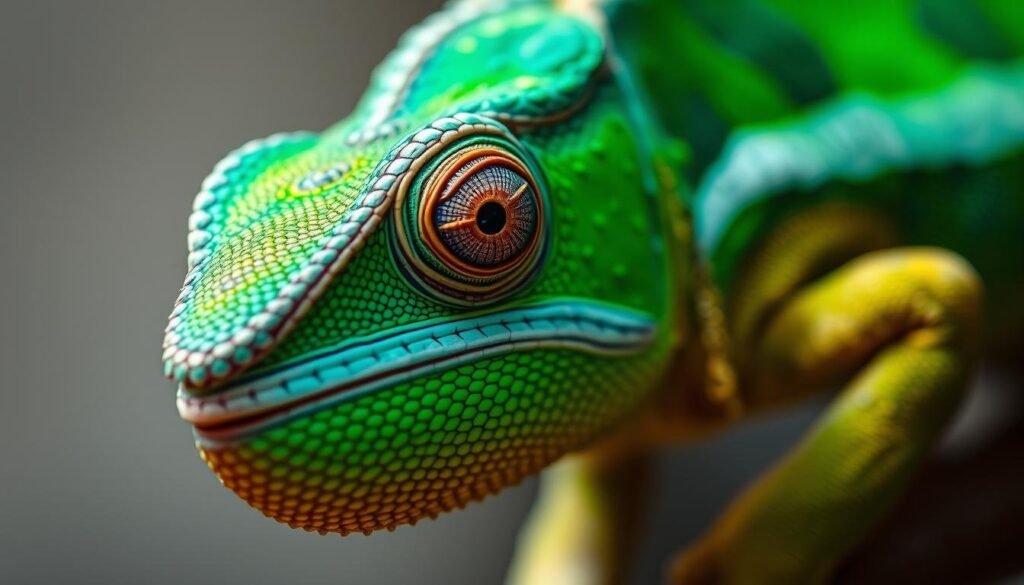Why Chameleons Change Color to Communicate? Have you ever wondered why chameleons can change their color? It’s not just for hiding. There’s more to it.
Chameleons use their color-changing ability for animal communication. It’s a key part of their reptile behavior. They change color to send messages to other chameleons.
This behavior is important for their social life. It helps them show feelings, plans, and even their rank. Let’s explore how chameleons change color and what they mean by it.
Contents
- 1 The Fascinating Science Behind Chameleon Color Changes
- 2 Why Do Chameleons Change Color for Communication?
- 3 Decoding the Messages in Chameleon Color Displays
- 4 Communication Patterns Across Different Chameleon Species
- 5 Conclusion: Why Chameleons Change Color to Communicate?
- 6 FAQ
- 6.1 What is the primary reason chameleons change color?
- 6.2 How do chameleons change color?
- 6.3 What are the different types of chromatophores responsible for color change in chameleons?
- 6.4 Do different chameleon species exhibit unique patterns of color change for communication?
- 6.5 What can be learned by studying chameleon color changes?
- 6.6 How do chameleons use color change to interact with other chameleons?
The Fascinating Science Behind Chameleon Color Changes
Chameleons can change color thanks to their skin cells. They have a special system that lets them switch colors. This is called biological color change.
Chromatophores are the cells behind this magic. They hold pigments that reflect light in different ways. There are three types: melanophores, iridophores, and xanthophores.
Melanophores make brown and black. Iridophores create silver and gold. Xanthophores give yellow and orange. By changing these cells, chameleons can show many colors and patterns.
Not all chameleons can change color the same way. It depends on their environment and how they communicate. Knowing this helps us understand their colorful language better.
Chameleons are more than just color changers. Their biology is full of wonders. The way their cells work together is truly fascinating.
Why Do Chameleons Change Color for Communication?
Chameleons change color to send messages, like emotions and intentions. This way of talking without words is key for their social life and staying alive.
They change color to show different things, like being aggressive, looking for a mate, or feeling stressed. For example, a bright color might mean they’re ready to fight or attract someone. A dull color could mean they’re feeling stressed or giving in. This lets them talk to other chameleons without making a sound.
The communication patterns of chameleons are really interesting. They use color changes to share complex info. This helps them show their feelings, plans, and status, which is important for their social life.
Chameleons are very good at showing their feelings through color. A stressed one might turn gray or brown. A chameleon looking for a mate might show off bright colors. This way of talking without words is crucial for their chameleon behavior.
Learning about these color changes helps us understand chameleons better. By studying their communication patterns, scientists can learn more about these amazing animals and their ways of life.
In short, chameleons’ ability to change color is a smart way to communicate. It’s essential for their survival and social life. By signaling emotions and plans through color, they can get along well in their complex world.
Decoding the Messages in Chameleon Color Displays
Looking at chameleons’ color changes can tell us a lot about their social lives and habits. Chameleons change color for many reasons, and knowing these changes helps us understand their behavior.

Studies show that different situations make chameleons change color in unique ways. For example, males turn bright colors to attract females during courtship. This colorful display is not just for show; it’s a way to show off the male’s health and strength to the female.
In fights over territory, chameleons may change color to show who’s boss. Being able to read these color signals is key to understanding chameleon social groups.
- Bright colors often signal courtship or dominance.
- Duller colors may indicate stress or submission.
- Rapid color changes can signal agitation or threat response.
To really understand chameleon behavior, we need to study their color changes and other behaviors together. This way, researchers can get a better picture of how chameleons talk to each other.
For instance, watching a chameleon’s color display when it meets a predator can teach us about its defense tactics. Also, studying color changes in social situations can show us the details of chameleon communication.
Exploring chameleon communication shows us that their color displays are more than just cool. They are a peek into the complex social and behavioral lives of these animals.
Communication Patterns Across Different Chameleon Species
Chameleons are famous for their color-changing skills. But, each species has its own way of using this ability. Some change color more for talking to others, while others use body language more.
The veiled chameleon shows off bright colors when it’s time to find a mate or defend its territory. On the other hand, the panther chameleon might change color more because of its surroundings, like the temperature or how bright it is.
Every chameleon species has its own way of saying hello or showing who’s boss. For example, the Jackson’s chameleon changes color and posture to show it’s ready to mate or to say it’s in charge. Learning about these differences helps us understand how chameleons interact with each other.
Looking at how different chameleons communicate shows that their color-changing is more than just a trick. It’s a way they talk to each other. By studying this, we can see how complex and interesting their social lives are.
- Some species change color mainly for social stuff, like finding a mate or showing off their territory.
- Others might change color because of things around them, like light or temperature.
- The way chameleons communicate shows how adaptable and creative they are.
Exploring the world of chameleons reveals that their color-changing is just part of their amazing ways of talking. The variety in how they communicate shows how complex and rich their behavior is.
Conclusion: Why Chameleons Change Color to Communicate?
Now you know chameleons change color for many reasons, including communication. Learning about their color changes helps us appreciate these amazing animals more.
The colorful language of chameleons shows their special place in the animal world. By studying their communication, we learn more about their behavior and how color plays a big role in their interactions.
More research on chameleons will help us understand their communication better. It will also reveal more about their social interactions, making us see animal behavior in a new light.
See Also: Why Flamingos Stand on One Leg: The Surprising Reason
FAQ
What is the primary reason chameleons change color?
Chameleons change color mainly to talk to other chameleons. They share feelings, plans, and status through color changes.
How do chameleons change color?
Chameleons change color with special cells called chromatophores. These cells have pigments that reflect light. This lets them show many colors and patterns.
What are the different types of chromatophores responsible for color change in chameleons?
Chameleons have three types of chromatophores. Melanophores make brown and black. Iridophores reflect light for silver and gold. Xanthophores create yellow and orange with carotenoids.
Do different chameleon species exhibit unique patterns of color change for communication?
Yes, each chameleon species has its own way of changing color. Some change color more for talking, while others use body language more.
What can be learned by studying chameleon color changes?
Studying chameleon color changes teaches us about their behavior and social life. We learn about their communication, like during mating, fights, or when they sense danger.
How do chameleons use color change to interact with other chameleons?
Chameleons change color to talk to others without sound. They signal aggression, courtship, or stress. It’s a way to communicate complex messages.

Zyair Larson, based in Denver, Colorado, has over 12 years of experience studying animal behavior. He has worked with the World Wildlife Fund (WWF) and National Geographic, researching wildlife and sharing insights on animal habits globally.

